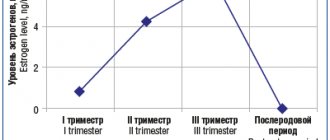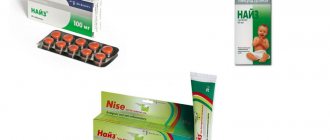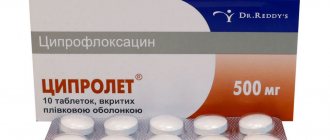Ketorolac-LF tablets p/o 10 mg No. 10x5
Name
Ketorolac-lf.
Release forms
Pills.
INN
Ketorolac.
Pharmacotherapeutic group
Nonsteroidal anti-inflammatory and antirheumatic drugs. Derivatives of acetic acid and their analogues. ATX code М01АВ15
Compound
Each tablet contains: active substance: ketorolac tromethamine – 10 mg; excipients: microcrystalline cellulose, corn starch, colloidal silicon dioxide anhydrous, magnesium stearate, lactose monohydrate, Opadry II white (partially hydrolyzed polyvinyl alcohol, titanium dioxide, macrogol/PEG, talc).
Indications for use
Ketorolac-LF, film-coated tablets, 10 mg is used for short-term treatment of acute pain (including postoperative pain) of moderate intensity, only as a continuation of previous parenteral (intramuscular or intravenous) therapy in a hospital setting, if necessary. The total duration of parenteral and oral therapy with ketorolac should not exceed 5 days.
Directions for use and dosage
For oral administration. The maximum daily dose is 4 tablets (40 mg). The duration of the course is no more than 5 days. The dosage regimen is set individually depending on the pain syndrome. To minimize side effects, the drug should be used at the lowest effective dose for the shortest period of time necessary to control symptoms. For children under 16 years of age, use is contraindicated. Adults from 16 to 64 years old, with a body weight exceeding 50 kg, are prescribed 1 tablet (10 mg) 3-4 times a day. For adults over 64 years of age, and/or with a body weight of less than 50 kg, and/or with impaired renal function, the frequency of use of the drug is reduced to 1-2 times a day.
Side effect
From the digestive tract: peptic ulcer, perforation or gastrointestinal bleeding, sometimes fatal (especially in the elderly), nausea, dyspepsia, gastrointestinal pain, abdominal discomfort, hematemesis, gastritis, esophagitis, diarrhea, belching, constipation, flatulence, feeling of fullness in the stomach, melena, rectal bleeding, ulcerative stomatitis, vomiting, hemorrhage, perforation, pancreatitis, exacerbation of colitis and Crohn's disease. From the central nervous system: anxiety, blurred vision, optic neuritis, drowsiness, dizziness, increased sweating, dry mouth, nervousness, paresthesia, functional disorders, depression, euphoria, convulsions, inability to concentrate, insomnia, increased fatigue, agitation, vertigo , impaired taste and vision, myalgia, unusual dreams, confusion, hallucinations, hyperkinesia, hearing loss, tinnitus, psychotic reactions, thinking disorders. Infectious diseases: aseptic meningitis (especially in patients with autoimmune diseases such as systemic lupus erythematosus, mixed connective tissue disease), stiff neck, headache, nausea, vomiting, fever, confusion. Metabolism and nutrition: anorexia, hyponatremia, hyperkalemia. From the urinary system: increased urinary frequency, oliguria, acute renal failure, hemolytic uremic syndrome, flank pain (with/without hematuria), increased serum urea and creatinine, interstitial nephritis, urinary retention, nephrotic syndrome, infertility, renal failure. From the liver: impaired liver function, hepatitis, jaundice and liver failure, increased functional tests. From the cardiovascular system: flushing of the face, bradycardia, pallor, hypertension, hypotension, palpitation, chest pain, edema, heart failure. Data from clinical and epidemiological studies indicate that the use of certain NSAIDs, especially in high doses and for long periods of time, may be associated with an increased risk of arterial thromboembolic complications (myocardial infarction or stroke). From the respiratory system: nosebleeds, shortness of breath, asthma, pulmonary edema. From the blood system: purpura, thrombocytopenia, neutropenia, agranulocytosis, aplastic and hemolytic anemia. Skin: itching, urticaria, photosensitivity of the skin, Lyell's syndrome, bullous reactions, including Stevens-Johnson syndrome and toxic epidermal necrolysis (very rare), exfoliative dermatitis, maculopapular rashes. Effect on reproductive function: the use of ketorolac, like any drug that inhibits the synthesis of cyclooxygenase/prostaglandin, can cause infertility. Hypersensitivity: Hypersensitivity reactions have been reported, which include nonspecific allergic reactions and anaphylaxis, respiratory tract reactivity including asthma, worsening asthma, bronchospasm, laryngeal edema or shortness of breath, and a variety of skin disorders that include various types of rashes, itching , urticaria, purpura, angioedema, and in isolated cases, exfoliative and bullous dermatitis (including epidermal necrolysis and erythema multiforme). Such reactions may occur in patients with or without known hypersensitivity to ketorolac or other non-steroidal anti-inflammatory drugs. They may also occur in individuals with a history of angioedema, bronchospastic reactivity (eg, asthma, and nasal polyps). Anaphylactoid reactions, such as anaphylaxis, can be fatal. Others: postoperative bleeding from a wound, hematoma, prolongation of bleeding, asthenia, edema, weight gain, increased body temperature, excessive thirst, fatigue, malaise, fever, chest pain.
Contraindications
Hypersensitivity to ketorolac or any component of the drug. Patients with active peptic ulcer disease, recent gastrointestinal bleeding or perforation, or a history of peptic ulcer disease or gastrointestinal bleeding. Bronchial asthma, rhinitis, angioedema or urticaria caused by the use of acetylsalicylic acid or other non-steroidal anti-inflammatory drugs (due to the possibility of severe anaphylactic reactions). History of bronchial asthma. Do not use as an analgesic before or during surgery. Severe heart failure. Complete or partial nasal polyp syndrome, angioedema or bronchospasm. Do not use in patients who have had surgery with a high risk of hemorrhage or incomplete bleeding control and in patients who receive anticoagulants, including low doses of heparin (2500-5000 units every 12 hours). Hepatic or moderate and severe renal failure (serum creatinine more than 160 µmol/l). Suspected or confirmed cerebrovascular bleeding, bleeding diathesis, including coagulation disorders and high risk of bleeding. Concomitant treatment with other non-steroidal anti-inflammatory drugs (NSAIDs) (including selective cyclooxygenase inhibitors), acetylsalicylic acid, warfarin, pentoxifylline, probenecid or lithium salts. Hypovolemia, dehydration. The period of pregnancy, labor, childbirth and breastfeeding. Children's age up to 16 years.
Overdose
Symptoms: headache, nausea, vomiting, epigastric pain, gastrointestinal bleeding; rarely - diarrhea, disorientation, agitation, coma, drowsiness, dizziness, ringing in the ears, loss of consciousness, sometimes convulsions. In cases of severe poisoning, acute renal failure and liver damage are possible. Anaphylactoid reactions have been observed after therapeutic use of NSAIDs, which may occur after overdose. Treatment: gastric lavage, use of activated carbon. It is necessary to ensure sufficient diuresis. Kidney and liver function should be carefully monitored. Patients should be monitored for at least 4 hours after ingestion of a potentially toxic amount. Frequent or prolonged seizures should be treated with intravenous diazepam. Other measures may be prescribed depending on the patient's clinical condition. Therapy is symptomatic.
Precautionary measures
The maximum duration of treatment should not exceed 5 days. Effect on fertility. The use of ketorolac, like any drug that inhibits cyclooxygenase/prostaglandin synthesis, may impair fertility and is not recommended for use by women who are planning to become pregnant. For women who are unable to become pregnant or are undergoing fertility investigations, discontinuation of ketorolac should be considered. Gastrointestinal bleeding, ulceration and perforation. Gastrointestinal bleeding, ulceration or perforation, which may be fatal, has been reported with the use of NSAIDs at any time during treatment, with or without warning symptoms or in the case of a history of severe gastrointestinal disorders. The risk of severe gastrointestinal bleeding depends on the dosage of the drug. This particularly applies to elderly patients who use ketorolac at an average daily dose of more than 60 mg. For these patients, as well as for patients who are concomitantly using low doses of acetylsalicylic acid or other drugs that may increase gastrointestinal risk, combination treatment with protective agents (eg, misoprostol or proton pump inhibitors) should be considered. The drug Ketorolac-LF is used with caution in patients who are receiving concurrent drug treatment that may increase the risk of ulceration or bleeding, such as oral corticosteroids, selective serotonin reuptake inhibitors or antiplatelet agents such as acetylsalicylic acid. If gastrointestinal bleeding or ulceration occurs in patients receiving Ketorolac-LF, the course of treatment should be discontinued. Respiratory dysfunction. Caution is required when using the drug in patients with bronchial asthma (or with a history of asthma), since NSAIDs have been reported to accelerate the onset of bronchospasm in such patients. Effect on the kidneys. Prostaglandin biosynthesis inhibitors (including NSAIDs) have been reported to have nephrotoxic effects. The drug should be prescribed with caution to patients with impaired renal, cardiac, or liver function, since the use of NSAIDs may lead to deterioration of renal function. Patients with mildly impaired renal function are prescribed lower doses of ketorolac (those that do not exceed 60 mg per day intramuscularly or intravenously), and the renal condition of such patients should be carefully monitored. As with other drugs that inhibit prostaglandin synthesis, increases in serum urea, creatinine and potassium have been reported during use of ketorolac tromethamine, which may occur after a single dose. Disorders of the cardiovascular system, kidneys and liver. Prescribe the drug with caution to patients with conditions that lead to a decrease in blood volume and/or renal blood flow, when renal prostaglandins play a supporting role in ensuring renal perfusion. In these patients, renal function should be monitored. The volume reduction should be corrected and serum urea and creatinine levels and the volume of urine excreted carefully monitored until the patient becomes normovolemic. In patients on renal dialysis, the clearance of ketorolac was reduced by approximately half the normal rate, and the terminal half-life was approximately tripled. Patients with impaired liver function due to cirrhosis did not have any clinically significant changes in ketorolac clearance or terminal half-life. Borderline increases in one or more liver function tests may occur. These abnormalities may be temporary, may remain unchanged, or may progress with continued treatment. If clinical signs and symptoms indicate the development of liver disease or if systemic manifestations are observed, the drug should be discontinued. Fluid retention and swelling. Fluid retention and edema have been reported during use of ketorolac and should be used with caution in patients with cardiac decompensation, hypertension, or similar conditions. Cardiovascular and cerebrovascular effects. There is currently insufficient information to assess such a risk for ketorolac tromethamine. Patients with uncontrolled hypertension, congestive heart failure, diagnosed coronary artery disease, peripheral arterial disease and/or cerebrovascular disease should be under medical supervision. Systemic lupus erythematosus and mixed connective tissue diseases. In patients with systemic lupus erythematosus and various mixed connective tissue diseases, the risk of developing aseptic meningitis increases. Dermatological reactions. The drug should be discontinued at the first signs of a skin rash, damage to the mucous membranes or any other signs of hypersensitivity. Anaphylactic (anaphylactoid) reactions. As with the use of other NSAIDs, anaphylactic (anaphylactoid) reactions (including anaphylaxis, bronchospasm, flushing, rash, hypotension, laryngeal edema, Quincke's edema) may occur in patients who have no or no history of hypersensitivity to aspirin, other NSAIDs or ketorolac. This set of symptoms may also occur in individuals with a history of bronchospastic reactivity (eg, asthma) and nasal polyps. Anaphylactoid reactions, such as anaphylaxis, can be fatal. Therefore, ketorolac should not be taken by patients with a history of asthma, and by patients with complete or partial nasal polyp syndrome, angioedema and bronchospasm. If anaphylactoid reactions occur, seek emergency medical attention. Hematological effects. Patients with bleeding disorders should not be prescribed the drug. Patients receiving anticoagulant therapy may have an increased risk of bleeding if ketorolac is used concomitantly. Patients receiving other medications that may affect the rate of bleeding control should be carefully monitored when ketorolac is prescribed to them. In controlled clinical trials, the incidence of significant postoperative bleeding was less than 1%. Ketorolac inhibits platelet aggregation and prolongs bleeding time. In patients with normal bleeding times, the duration of bleeding increased, but did not exceed the normal range of 2-11 minutes. In contrast to the long-term effects resulting from the use of acetylsalicylic acid, platelet function returns to normal within 24-48 hours after discontinuation of ketorolac. Ketorolac should not be prescribed to patients who have undergone surgery with a high risk of bleeding or incomplete control of bleeding. Caution should be used if mandatory bleeding control is critical. Ketorolac-LF is not an anesthetic agent and does not have sedative or anxiolytic properties; therefore, it is not recommended as a pre-operative sedative to maintain anesthesia. Should not be used in patients with rare hereditary diseases: congenital galactosemia, lactase deficiency, glucose/galactose malabsorption syndrome.
Children
Not for use in children under 16 years of age.
Use during pregnancy and lactation
The safety of ketorolac during pregnancy in humans has not been established. Given the known effect of NSAIDs on the cardiovascular system of the fetus (risk of premature closure of the ductus arteriosus), ketorolac is contraindicated during pregnancy, labor and childbirth. The onset of labor may be delayed and the duration prolonged, with an increased tendency for bleeding to occur in both mother and baby. Ketorolac is excreted into breast milk in small quantities, therefore the drug Ketorolac-LF is contraindicated during breastfeeding.
Impact on the ability to drive vehicles and operate machinery
Some patients may experience drowsiness, dizziness, vertigo, insomnia, fatigue, blurred vision or depression when using ketorolac. If patients experience the above or other similar side effects, they should not drive or operate machinery.
Interaction with other drugs
Ketorolac easily binds to plasma proteins (average value 99.2%), and the degree of binding depends on the concentration. Cannot be used simultaneously with ketorolac. Due to the possibility of side effects, ketorolac should not be prescribed with other NSAIDs, including selective cyclooxygenase-2 inhibitors, or in patients receiving acetylsalicylic acid, warfarin, lithium, probenecid, cyclosporine. NSAIDs should not be prescribed within 8-12 days after using mifepristone, since NSAIDs may weaken the effect of mifepristone. Medicines in combination with ketorolac should be prescribed with caution. In healthy normovolemic individuals, ketorolac reduces the diuretic effect of furosemide by approximately 20%; therefore, the drug is prescribed with particular caution to patients with cardiac decompensation. NSAIDs may worsen heart failure, reduce glomerular filtration rate, and increase plasma levels of cardiac glycosides when coadministered with cardiac glycosides. Ketorolac and other non-steroidal anti-inflammatory drugs may weaken the effect of antihypertensive drugs. In the case of simultaneous use of ketorolac with ACE inhibitors, there is an increased risk of renal dysfunction, especially in patients with a reduced blood volume in the body. There is a possible risk of nephrotoxicity if NSAIDs are prescribed with tacrolimus. Co-administration with diuretics may lead to a weakening of the diuretic effect and an increased risk of NSAID nephrotoxicity. As with all NSAIDs, caution is required when coadministering corticosteroids due to the increased risk of gastrointestinal ulceration or bleeding. There is an increased risk of gastrointestinal bleeding if NSAIDs are prescribed in combination with antiplatelet agents and selective serotonin reuptake inhibitors. Caution is advised if methotrexate is coadministered as some prostaglandin synthesis inhibitors have been reported to reduce the clearance of methotrexate and therefore possibly increase its toxicity. Patients taking NSAIDs and quinolones may have an increased risk of developing seizures. Concomitant use of NSAIDs with zidovudine leads to an increased risk of hematological toxicity. There is an increased risk of hemarthrosis and hematoma in HIV-infected people who have hemophilia and who are treated with both zidovudine and ibuprofen. The following drugs are unlikely to interact with ketorolac. Ketorolac did not affect the binding of digoxin to plasma protein. In vitro studies indicate that at therapeutic concentrations of salicylate (300 μg/ml) and higher, ketorolac binding was reduced by approximately 99.2% to 97.5%. Therapeutic concentrations of digoxin, warfarin, paracetamol, phenytoin and tolbutamide did not affect the binding of ketorolac to plasma protein. Because ketorolac is a highly active drug and its available plasma concentration is low, it is not expected to significantly replace other drugs that bind to plasma proteins. There is no evidence from animal or human studies that ketorolac tromethamine induces or inhibits liver enzymes that are capable of metabolizing it or other drugs. Therefore, ketorolac is not expected to alter the pharmacokinetics of other drugs through mechanisms of enzyme induction or inhibition.
Storage conditions
In a place protected from moisture and light at a temperature not exceeding 25 °C. Keep out of the reach of children.
Best before date
2 years. Do not use after the expiration date stated on the packaging.
Package
10 tablets each in a blister pack made of polymer film and aluminum foil. Two, three or five blister packs along with instructions for medical use in a cardboard pack.
Vacation conditions
On prescription.
Buy Ketorolac-LF tablets p/o 10 mg No. 10x5 in the pharmacy
Price for Ketorolac-LF tablets p/o 10 mg No. 10x5
Instructions for use for Ketorolac-LF tablets p/o 10 mg No. 10x5
Ketonof-LF
Description Film -coated tablets, white, with a biconvex surface. Composition Each tablet contains: ketorolac tromethamine – 10 mg; microcrystalline cellulose, corn starch, aerosil, magnesium stearate, lactose monohydrate, opadry II white (talc, polyethylene glycol, titanium dioxide, polyvinyl alcohol).
Release form Film-coated tablets, 10 mg. Pharmacotherapeutic group Non-steroidal anti-inflammatory drugs. ATX code М01АВ15
Indications for use Ketorolac tablets are prescribed for short-term relief of moderate postoperative pain. The maximum duration of treatment is seven days.
Method of administration and dosage For oral administration. The dosage regimen is set individually depending on the pain syndrome. Adults from 16 to 64 years old, with a body weight exceeding 50 kg, are usually prescribed 1 tablet (10 mg) 3-4 times a day. For adults weighing less than 50 kg or with impaired renal function, the frequency of use of the drug is reduced to 1-2 times a day. The maximum daily dose is 4 tablets (40 mg). The duration of the course is no more than 7 days.
Side effects From the digestive system: often found - gastralgia, diarrhea; less often - stomatitis, flatulence, constipation, vomiting, feeling of fullness in the stomach; rarely - loss of appetite, nausea, erosive and ulcerative lesions of the gastrointestinal tract (including with perforation and/or bleeding - abdominal pain, spasm or burning in the epigastric region, blood in the stool or melena, vomiting with blood or “coffee grounds” type, nausea, heartburn, etc.), cholestatic jaundice, hepatitis, hepatomegaly, acute pancreatitis. From the urinary system: acute renal failure, lower back pain, hematuria, azotemia, hemolytic-uremic syndrome (hemolytic anemia, renal failure, thrombocytopenia, purpura), increased frequency of urination, increased or decreased urine volume, nephritis, edema of renal origin. From the senses: hearing loss, ringing in the ears, visual impairment (including blurred visual perception). From the respiratory system, chest and mediastinum: bronchospasm or dyspnea, rhinitis, pulmonary edema, laryngeal edema (shortness of breath, difficulty breathing), nosebleeds. From the central nervous system: headache, dizziness, drowsiness, aseptic meningitis (fever, severe headache, convulsions, stiffness of the neck and/or back muscles), hyperactivity (mood changes, anxiety), hallucinations, depression, psychosis, fainting. Vascular disorders: arterial hypertension, hypotension, hematomas, redness, pallor, postoperative bleeding. From the heart: palpitations, bradycardia, heart failure. From the hematopoietic organs: rarely - anemia, eosinophilia, leukopenia. From the hemostatic system: bleeding from a postoperative wound, rectal bleeding. Skin: skin rash (including maculopapular rash), purpura, exfoliative dermatitis (fever with or without chills, flushing, thickening or flaking of the skin, swelling and/or tenderness of the tonsils), urticaria, erythema maligna exudative (Steven-Johnson syndrome) ) and toxic epidermal necrolysis (Lyell's syndrome) (very rare). From the musculoskeletal system and connective tissue: myalgia, functional disorders. Metabolism and nutrition: anorexia, hyperkalemia, hyponatremia. Allergic reactions: rarely - anaphylaxis or anaphylactoid reactions (change in facial skin color, skin rash, urticaria, itching of the skin, tachypnea or dyspnea, swelling of the eyelids, periorbital edema, shortness of breath, difficulty breathing, heaviness in the chest, wheezing). Other: swelling (face, legs, ankles, fingers, feet, weight gain), increased sweating, swelling of the tongue, fever.
Contraindications Hypersensitivity to ketorolac or any component of the drug. Bronchial asthma, rhinitis, angioedema or urticaria caused by the use of acetylsalicylic acid or other non-steroidal anti-inflammatory drugs of the pyrazolone series (due to the possibility of severe anaphylactic reactions), severe heart failure, inflammatory bowel diseases. Do not use in patients who have had surgery with a high risk of hemorrhage or incomplete bleeding control and in patients who receive anticoagulants, including low doses of heparin (2500-5000 units every 12 hours). Hepatic or moderate and severe renal failure (serum creatinine clearance more than 160 µmol/l). Suspected or confirmed cerebrovascular bleeding, bleeding diathesis, including coagulation disorders and high risk of bleeding. Simultaneous treatment with warfarin, pentoxifylline, probenecid or lithium salts. Hypovolemia, dehydration. The period of pregnancy, labor, childbirth and breastfeeding; Children's age up to 16 years. Overdose Symptoms: an overdose of ketorolac with a single dose is manifested by abdominal pain, nausea, vomiting, hyperventilation, symptoms of a stomach ulcer and/or erosive gastritis, and impaired renal function, which disappear after discontinuation of the drug. Rarely, gastrointestinal hematopoiesis, arterial hypertension, acute renal failure, respiratory depression and coma may develop. Overdose may manifest as headache, epigastric pain, disorientation, agitation, drowsiness, dizziness, tinnitus, and fainting. Rarely diarrhea and seizures develop. Anaphylactoid reactions have been reported with the use of ketorolac in therapeutic doses and in overdose. Treatment: Treatment is symptomatic, aimed at maintaining vital functions. There is no specific antidote. Dialysis does not significantly reduce the level of ketorolac in the blood. During the first hour after taking a potentially toxic dose of ketorolac, gastric lavage and activated charcoal administration are necessary. It is necessary to ensure sufficient diuresis and constantly monitor liver and kidney functions. The patient should be monitored for at least 4 hours after taking a potentially toxic dose. Frequent or prolonged seizures must be treated with intravenous diazepam. Other measures are prescribed depending on the patient's condition. Precautions Hypersensitivity to other non-steroidal anti-inflammatory drugs; bronchial asthma; the presence of factors that increase the toxicity of the drug for the gastrointestinal tract: alcoholism, smoking and cholecystitis; postoperative period, chronic heart failure, edema syndrome, arterial hypertension, renal dysfunction (plasma creatinine below 50 mg/l), cholestasis, active hepatitis, sepsis, systemic lupus erythematosus, concomitant use with other non-steroidal anti-inflammatory drugs, in elderly patients ( over 65 years of age), adverse reactions characteristic of NSAIDs are more likely to occur, therefore it is recommended that this category of patients be prescribed doses that are at the lower limit of the therapeutic range.
Special instructions Effect on fertility. The use of ketorolac may impair fertility and is not recommended for use by women who are planning to become pregnant. For women who are unable to become pregnant or are undergoing fertility investigations, discontinuation of ketorolac should be considered. Kidney and liver disorders. The drug is prescribed with caution to patients with impaired renal and liver function. In patients with mild renal impairment, lower doses of ketorolac are prescribed, and the renal condition of such patients should be carefully monitored. As with other drugs that inhibit prostaglandin synthesis, increases in serum urea, creatinine and potassium have been reported during use of ketorolac, which may occur after a single dose. The drug should be prescribed with caution to patients with conditions that lead to a decrease in blood volume and/or renal blood flow. In these patients, renal function should be monitored. The volume reduction should be corrected and serum urea and creatinine levels and the volume of urine excreted carefully monitored until the patient becomes normovolemic. In patients on renal dialysis, the clearance of ketorolac was reduced by approximately half the normal rate, and the terminal half-life was approximately tripled. Patients with impaired liver function due to cirrhosis did not have any clinically significant changes in ketorolac clearance or terminal half-life. Borderline increases in one or more liver function tests may occur. These abnormalities may be temporary, may remain unchanged, or may progress with continued treatment. If clinical signs and symptoms indicate the development of liver disease or if systemic manifestations are observed, the drug should be discontinued. Cardiovascular and cerebrovascular effects. When using ketorolac, blood pressure monitoring is necessary for patients suffering from arterial hypertension and heart failure. This is due to fluid retention and the development of edema when using NSAIDs. Clinical studies and epidemiological data suggest that the use of coxibs and some other NSAIDs (especially at high doses) may increase the risk of arterial thrombosis (eg, myocardial infarction or stroke). Although ketorolac does not increase the incidence of thrombotic events such as myocardial infarction, there is insufficient data to completely rule out such a risk. In patients with uncontrolled hypertension and heart failure, coronary artery disease, peripheral arterial disease and/or cerebrovascular disease, ketorolac should be prescribed after a careful assessment of the risk/benefit ratio. A similar approach before starting treatment should be applied to patients with risk factors for cardiovascular disease (for example, hypertension, hyperlipidemia, diabetes mellitus, smoking). Gastrointestinal disorders: Gastrointestinal ulcers, bleeding and perforation, which can be fatal, occur with all NSAIDs, including ketorolac, at any time during treatment, often without prior symptoms or without a history of serious complications from the gastrointestinal tract. In elderly people, people with a history of gastrointestinal bleeding, in debilitated patients or patients receiving high doses of ketorolac, the risk of developing adverse reactions from the gastrointestinal tract is higher, and the consequences of these adverse reactions can be fatal. These patients should begin treatment with the lowest dose; This may include recommended therapy with misoprostol or proton pump inhibitors. Combination therapy is also prescribed to patients simultaneously receiving low doses of aspirin or its analogues. For elderly people, it is recommended to increase the interval between doses of ketorolac. NSAIDs should be prescribed with caution to patients with inflammatory bowel diseases (ulcerative colitis, Crohn's disease). Patients with a history of gastrointestinal adverse reactions, especially the elderly, should report any unusual abdominal symptoms, especially during the initial stages of treatment. If adverse reactions from the gastrointestinal tract are detected, it is necessary to discontinue ketorolac. Ketorolac should be prescribed with caution to patients receiving concomitant treatment with oral corticosteroids, selective serotonin reuptake inhibitors, or antiplatelet agents. Systemic lupus erythematosus and mixed connective tissue diseases. In patients with systemic lupus erythematosus and various mixed connective tissue diseases, the risk of developing aseptic meningitis increases. Dermatological effects. Ketorolac should be discontinued at the first signs of a skin rash, damage to the mucous membranes or any other signs of hypersensitivity. Hematological effects. Patients with bleeding disorders should not be prescribed ketorolac. Patients receiving anticoagulant therapy may have an increased risk of bleeding if ketorolac is used concomitantly. Patients receiving other drugs that may affect the rate of bleeding control should be carefully monitored when ketorolac is prescribed to them. In controlled clinical trials, the incidence of significant postoperative bleeding was less than 1%. Ketorolac inhibits platelet aggregation and prolongs bleeding time. In patients with normal bleeding times, the duration of bleeding increased, but did not exceed the normal range of 2-11 minutes. In contrast to the long-term effects resulting from the use of acetylsalicylic acid, platelet function returns to normal within 24-48 hours after discontinuation of ketorolac. The drug is not an anesthetic and does not have sedative or anxiolytic properties; therefore, it is not recommended as a pre-operative sedative to maintain anesthesia. Use with caution in patients with rare hereditary diseases: congenital galactosemia, lactase deficiency, glucose/galactose malabsorption syndrome. Interaction with other drugs Simultaneous use with acetylsalicylic acid or other NSAIDs, calcium preparations, glucocorticosteroids, ethanol, corticotropin can lead to the formation of gastrointestinal ulcers and the development of gastrointestinal bleeding. Patients taking both NSAIDs and fluoroquinolone antibiotics have a higher incidence of seizures. Concomitant use with zidovudine leads to an increased risk of hematological toxicity. There is an increased risk of hemarthrosis and hematoma in HIV-infected people who have hemophilia and who are treated with both zidovudine and ibuprofen. Co-administration with paracetamol increases the risk of developing nephrotoxicity, and with methotrexate - hepato- and nephrotoxicity. Co-administration of ketorolac with methotrexate is possible only when using low doses of the latter (monitor the concentration of methotrexate in the blood plasma). There is a possible risk of nephrotoxicity if ketorolac is co-administered with tacrolimus. Probenecid reduces the plasma clearance and volume of distribution of ketorolac, increases its concentration in the blood plasma and increases the half-life. With the use of ketorolac, the clearance of methotrexate and lithium may decrease and the toxicity of these substances may increase. Co-administration with indirect anticoagulants (coumarin and indandione derivatives), heparin, thrombolytics, antiplatelet agents, cefoperazone, warfarin, cefotetan and pentoxifylline increases the risk of bleeding. Reduces the effect of antihypertensive and diuretic drugs (the synthesis of prostaglandins in the kidneys decreases). In healthy normovolemic individuals, ketorolac reduces the diuretic effect of furosemide by approximately 20%; therefore, the drug is prescribed with particular caution to patients with cardiac decompensation. When combined with opioid analgesics, the doses of the latter may be reduced. With simultaneous use, the hypoglycemic effect of insulin and oral hypoglycemic drugs increases (dose adjustment is necessary). Increases the concentrations of verapamil and nifedipine in the blood plasma. In rare cases, the development of convulsive attacks when ketorolac is combined with anticonvulsants (phenytoin, carbamazepine); the occurrence of hallucinations while taking ketorolac and psychostimulant drugs (fluoxetine, thiothixene, alprazolam). Administration with sodium valproate causes disruption of platelet aggregation. When prescribed with other nephrotoxic drugs (including gold preparations), the risk of developing nephrotoxicity increases. Drugs that block tubular secretion reduce the clearance of ketorolac and increase its concentration in the blood plasma.
Use during pregnancy and lactation The use of ketorolac is contraindicated during pregnancy, during labor and childbirth. Do not use during breastfeeding due to the possible negative effects of prostaglandin synthesis inhibitors on infants.
Effect on the ability to drive vehicles and operate machinery During the treatment period, care must be taken when driving vehicles and engaging in other potentially hazardous activities that require increased concentration of attention and speed of psychomotor reactions, since a significant proportion of patients when prescribed the drug develop side effects from the central nervous system. nervous system (including drowsiness, dizziness, headache).
Storage conditions Protected from moisture and light at a temperature not exceeding 25 ºС. Keep out of the reach of children.
Shelf life: 2 years. Do not use after the expiration date stated on the packaging.
Packaging 10 tablets in a blister pack. Two, three or five contour packs of 10 tablets per pack.
Ketofril® (Ketofreel®)
Often - more than 3%, less often - 1-3%, rarely - less than 1%.
From the digestive system
: often (especially in elderly patients over 65 years of age with a history of erosive and ulcerative lesions of the gastrointestinal tract) - gastralgia, diarrhea; less often - stomatitis, flatulence, constipation, vomiting, feeling of fullness in the stomach; rarely - nausea, erosive and ulcerative lesions of the gastrointestinal tract (including with perforation and/or bleeding - abdominal pain, spasm or burning in the epigastric region, melena, vomiting like “coffee grounds”, nausea, heartburn, etc. .), cholestatic jaundice, hepatitis, hepatomegaly, acute pancreatitis.
From
the urinary system
: rarely - acute renal failure, lower back pain with or without hematuria and/or azotemia, hemolytic-uremic syndrome (hemolytic anemia, renal failure, thrombocytopenia, purpura), frequent urination, increased or decreased urine volume, nephritis, edema of renal origin.
From the senses
: rarely - hearing loss, ringing in the ears, visual impairment (including blurred vision).
From the respiratory system
: rarely - bronchospasm or dyspnea, rhinitis, laryngeal edema (shortness of breath, difficulty breathing).
From the side of the central nervous system
: often - headache, dizziness, drowsiness; rarely - aseptic meningitis (fever, severe headache, convulsions, stiffness of the neck and/or back muscles), hyperactivity (mood changes, anxiety), hallucinations, depression, psychosis.
From the cardiovascular system
: less often - increased blood pressure; rarely - pulmonary edema, fainting.
From the hematopoietic organs
: rarely - anemia, eosinophilia, leukopenia.
From the hemostasis system:
rarely - bleeding from a postoperative wound, nosebleeds, rectal bleeding.
From the skin
: less often - skin rash (including maculopapular rash), purpura; rarely - exfoliative dermatitis (fever with or without chills, redness, thickening or peeling of the skin, swelling and/or tenderness of the tonsils), urticaria, Stevens-Johnson syndrome, Lyell's syndrome.
Allergic reactions:
rarely - anaphylaxis or anaphylactoid reactions (change in facial skin color, skin rash, urticaria, skin itching, tachypnea or dyspnea, swelling of the eyelids, periorbital edema, shortness of breath, difficulty breathing, heaviness in the chest, wheezing).
Others
: often - swelling (face, legs, ankles, fingers, feet, weight gain); less often - increased sweating, rarely - swelling of the tongue, fever.
Ketoprofen
Undesirable drug combinations
The combined use of ketoprofen with other NSAIDs (including selective cyclooxygenase-2 inhibitors), salicylates in high doses is not recommended, due to the increased risk of gastrointestinal bleeding and ulceration of the gastrointestinal mucosa.
Simultaneous use with anticoagulants (heparin, warfarin), antiplatelet agents (ticlopidine, clopidogrel) increases the risk of bleeding. If the use of such a combination is unavoidable, the patient's condition should be carefully monitored.
When used simultaneously with lithium preparations, it is possible to increase the concentration of lithium in the blood plasma up to toxic values. The concentration of lithium in the blood plasma should be carefully monitored and the dose of lithium preparations should be promptly adjusted during and after treatment with NSAIDs.
Increases the hematological toxicity of methotrexate, especially when used in high doses (more than 15 mg per week). The time interval between stopping or starting therapy with ketoprofen and taking methotrexate should be at least 12 hours. Combinations to use with caution
During therapy with ketoprofen, patients taking diuretics, especially when dehydration develops, have a higher risk of developing renal failure due to a decrease in renal blood flow caused by inhibition of prostaglandin synthesis. Before starting to use ketoprofen in such patients, rehydration measures should be carried out. After starting treatment, it is necessary to monitor kidney function.
Combined use of the drug with angiotensin-converting enzyme inhibitors and angiotensin II receptor blockers in patients with impaired renal function (with dehydration, elderly patients) can lead to worsening deterioration of renal function, incl. to the development of acute renal failure.
During the first weeks of simultaneous use of ketoprofen and methotrexate at a dose not exceeding 15 mg per week, blood tests should be monitored weekly. In elderly patients or if there are any signs of renal impairment, the study should be performed more frequently.
Combinations to take into account
Ketoprofen may weaken the effect of antihypertensive drugs (beta blockers, ACE inhibitors, diuretics).
Concomitant use with selective serotonin reuptake inhibitors (SSRIs) increases the risk of gastrointestinal bleeding.
Concomitant use with thrombolytics increases the risk of bleeding.
Concomitant use with potassium salts, potassium-sparing diuretics, ACE inhibitors, angiotensin II receptor blockers, NSAIDs, low molecular weight heparins, cyclosporine, tacrolimus and trimethoprim increases the risk of developing hyperkalemia.
When used simultaneously with cyclosporine and tacrolimus, there may be a risk of additive nephrotoxicity, especially in elderly patients.
The use of several antiplatelet drugs (tirofiban, eptifibatide, abciximab, iloprost) increases the risk of bleeding.
Increases the plasma concentration of cardiac glycosides, slow calcium channel blockers, cyclosporine, methotrexate and digoxin.
Ketoprofen may enhance the effect of oral hypoglycemic and some anticonvulsants (phenytoin).
Concomitant use with probenecid significantly reduces the plasma clearance of ketoprofen.
Nonsteroidal anti-inflammatory drugs may reduce the effectiveness of mifepristone. Taking NSAIDs should be started no earlier than 8-12 days after stopping mifepristone.
Pharmaceutically incompatible with tramadol solution due to precipitation.
Spironolactone
Mode of application
Orally, after meals, 1 or 2 times a day. Taking the daily dose or the first part of the daily dose of the drug is recommended in the morning.
Adults
Essential hypertension
Additional therapy in the treatment of arterial hypertension in case of insufficient effectiveness of previously used antihypertensive drugs
The initial dose of spironolactone when used simultaneously with other antihypertensive drugs is 25 mg/day. If after 4 weeks the blood pressure does not reach the target values, the dose of the drug can be increased by 2 times. In hypertensive patients receiving medications that may cause hyperkalemia (eg, angiotensin-converting enzyme (ACE) inhibitors or angiotensin receptor blockers), serum potassium and creatinine levels should be assessed before initiating spironolactone.
The drug should not be used in patients whose serum potassium content exceeds 5.0 mmol/l and whose serum creatinine concentration exceeds 220 µmol/l. Frequent monitoring of potassium and creatinine levels in the blood is required for 3 months after starting spironolactone.
Congestive heart failure
Edema due to congestive heart failure or nephrotic syndrome
The initial dose is 100 mg and can vary from 25 to 200 mg/day; the drug can be taken in 1-2 doses. When taking higher doses, the drug can be used in conjunction with a diuretic that acts in the proximal renal tubule. In this case, the dose of spironolactone should be adjusted.
Adjunctive therapy in the treatment of severe heart failure (NYHA class III-IV and ejection fraction ≤ 35%)
It has been established that if the potassium content in the blood serum does not exceed 5.0 mmol/l, and the concentration of creatinine in the blood serum does not exceed 220 μmol/l, against the background of basic standard therapy, the dose of spironolactone at the beginning of use should be 25 mg/day. In patients with good tolerance of the drug at a dose of 25 mg/day, according to clinical indications, the dose can be increased to 50 mg/day. For patients with poor tolerance to drug therapy at a dose of 25 mg/day, the dose of the drug can be reduced to 25 mg once every 2 days.
Ascites and edema due to liver cirrhosis
If the ratio of sodium and potassium ions in the urine exceeds 1.0, then the daily dose of the drug should be 100 mg. If the specified ratio is less than 1.0, then the dose of the drug should be in the range from 200 to 400 mg/day.
The maintenance dose should be determined individually for each patient.
Hypokalemia
The drug is prescribed at a dose of 25-100 mg/day if the use of potassium supplements or other potassium-sparing methods is insufficient.
Primary hyperaldosteronism
For diagnostic purposes
1) Long-term test: spironolactone is taken 400 mg/day for 3-4 weeks. When correction of hypokalemia and arterial hypertension is achieved, the presence of primary hyperaldosteronism can be assumed.
2) Short test: spironolactone is taken 400 mg/day for 4 days. If the potassium content in the blood serum increases while taking spironolactone and decreases after its discontinuation, the presence of primary hyperaldosteronism can be assumed.
Treatment
In preparation for surgical treatment, spironolactone is used in doses of 100 to 400 mg/day. If surgery is not indicated, spironolactone can be used for long-term maintenance therapy at the lowest effective dose. In this case, the initial dose of the drug may be reduced every 14 days until the lowest effective dose is reached. To reduce the severity of side effects with long-term use, the drug is recommended to be used in combination with other diuretics.
Special patient groups
Children and teenagers under 18 years of age
The initial dose of the drug is 1-3 mg/kg body weight per day in 1-4 doses. When conducting maintenance therapy or when used simultaneously with other diuretics, the dose of the drug should be reduced to 1-2 mg/kg body weight.
When used in children under 3 years of age, a suspension can be used. To prepare a suspension, tablets should be crushed and mixed with liquid or pasty food. The suspension should be used immediately, immediately after preparation.
Elderly patients (over 65 years old)
It is recommended to start treatment with the drug with the lowest dose and gradually increase it until the maximum desired effect is achieved. Caution should be exercised in patients with severe renal or hepatic impairment, which may affect the metabolism and excretion of spironolactone. In addition, when using the drug in elderly patients, the risk of developing hyperkalemia should be taken into account (see section "Special Instructions").







